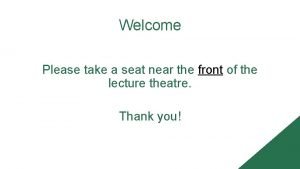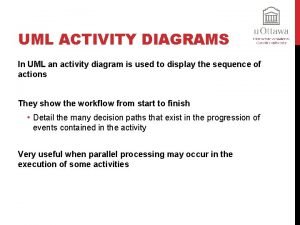Welcome and please join in Please work through



















- Slides: 19

Welcome and please join in Please work through each below: 1. Close your eyes, place your hands on the table and take 5 deep breaths. 1. Pray that The Holy Spirit opens your heart to what He has for you. 1. Read the entire passage to the right slowly, placing yourself in the story. 1. Reread the passage and this time notice where in the passage your are most drawn to. 1. Think deeply about why The Holy Spirit might have chosen these words to speak to you. 1. Pray based on what you have meditated and sensed during this time. 1. Be silent in the presence of God. That day when evening came, he said to his disciples, “Let us go over to the other side. ” Leaving the crowd behind, they took him along, just as he was, in the boat. There were also other boats with him. A furious squall came up, and the waves broke over the boat, so that it was nearly swamped. Jesus was in the stern, sleeping on a cushion. The disciples woke him and said to him, “Teacher, don’t you care if we drown? ” He got up, rebuked the wind and said to the waves, “Quiet! Be still!” Then the wind died down and it was completely calm. He said to his disciples, “Why are you so afraid? Do you still have no faith? ” They were terrified and asked each other, “Who is this? Even the wind and the waves obey him!”

Scripture Engagement Nick Rivera Pastor of Engage Community Church & Director of High school Discipleship at By The Hand Club for Kids Adapted from https: //www. biblegateway. com/resources/scriptureengagement/ and © Phil Collins, Ph. D. , 2014. This material was created in partnership with the Taylor University Center for Scripture Engagement.

Why Scripture Engagement? “To encounter the words of Scripture is to encounter God in action” (Timothy Ward, Words of Life, 2009).

What is Scripture Engagement? “Scripture engagement is interaction with the biblical text in a way that provides sufficient opportunity for the text to speak for itself by the power of the Holy Spirit, enabling readers and listeners to hear the voice of God and discover for themselves the unique claim Jesus Christ is making upon them. ” Dr. Fergus Macdonald, Taylor University “Bible engagement is the process whereby people are connected with the Bible such that they have meaningful encounters with Jesus Christ and their lives are progressively transformed in Him. ” Dr. Lawson Murray, President Scripture Union Canada “Bible engagement is "the process of taking in and living out God's Word for the purpose of knowing him better and experiencing him more. "” Whitney Kuniholm, President of Scripture Union USA

How can we Engage Scripture? ● meditate (Psalm 1: 2; Joshua 1: 8) ● reflect (2 Timothy 2: 7) ● look intently (James 1: 25) ● dwell (Colossians 3: 16) ● ponder (Psalm 119: 95) ● consider (Jeremiah 2: 31) ● eat (Jeremiah 15: 16; Revelation 10: 9 -11)

Meditate

Ruminate

Scripture Engagement is not. . . Scripture engagement is not exactly the same as studying the Bible; it is a complement to Bible study.

Scripture Engagement Practices Overview 1. 2. 3. 4. 5. 6. 7. Praying Scripture Picture it Journaling Lectio Divina Storying Scripture Memorizing Scripture Hand Copying Scripture

Praying Scripture ● “To pray the Scriptures is to order one’s time of prayer around a particular text in the Bible. ” Evan Howard, “Praying the Scriptures” ○ praying the prayers of the Bible word-for-word as your own prayers ○ personalizing portions of the Scriptures in prayer, or praying through various topics of the Bible. Tip: Select a passage that is meaningful to you and that you feel speaks truth into your life. A psalm is a great place to start this practice (e. g. , if you want to pray a prayer of praise to God, try Psalm 100). Take a moment to ask God to bless your time in Scripture, to keep you focused, and to help you pray his Word. Start reading through your passage slowly, meditating on each word and verse. As you finish a sentence or a verse, stop and turn your thoughts into a prayer. Bring the ideas or truths of the passage into a conversation with God. Use the words of the Bible to guide prayers of worship, confession, thanksgiving, and petition for yourself and others.

Picture it (Ignatian Method) ● This method is about engaging your imagination. God has given us the biblical stories so we can connect with them on all levels, learning who he is and what he cares about. In this method, you place yourself in the stories of Scripture in an attempt to better empathize with the people of the Bible and “experience” their stories. This is especially helpful for those who tend to connect to Scripture on a purely cognitive level, allowing them to experience more of the emotion of the text. Begin: Consider God’s presence and love for you. Kneel, sit, bow, however is most comfortable for you. Preparatory Prayer: Offer God your time and focus. Contemplate the Biblical Story: Choose a story… ● ● ● Read the text: slowly and notice details. Place yourself inside the text: character or onlooker Participate: become part of the scene. Observe: What is happening around you? What’s the feel, smell, sound, look? Ground your imagination in the text. Dialogue with characters: What are people saying around me, to each other and to me? What do I say? Notice what is going on inside you: What are you feeling as you interact with the text in this way? Happy, sorrow, confusion. . . Conversation with Jesus Closing Prayer

Journaling Scripture ● ● ● A conversation with God. A place where you can safely record and reflect on your raw thoughts and feelings, ask questions, search for patterns, and develop your own thoughts with the Holy Spirit as your guide. Helps us to reflect on a passage, focusing our mind and helping us concentrate. Engage with the content at a deeper level and remember it more completely and as a result the content has more impact on our lives. S – Scripture: Write out the scripture. O – Observations: Examine the text and write down what you notice. ● ● ● What jumps out to you in the passage? Who is it written by? Who is it written to? What’s one thing you didn’t notice before? What seems interesting or unusual? What comes before and after the text? Is there repetition, comparison, or contrast? A – Applications: Apply God’s Word to your life in a practical way. This is the part where you personalize your study of Scripture. ● ● How does it apply to you? Is there a specific action the Holy Spirit is pressing on your heart or a confession of sin need to make? P – Prayer: Respond to God’s Word with your own words. Thanksgiving, repentance, praise and worship etc.

Lectio Divina ● ● ● Sacred reading practiced by monks who spent a large portion of their days praying and reading Scripture. While reading they noticed that at times individual words, phrases, or verses seemed to leap off of the page with a special personal importance. an intimate way of communicating with the Lord that employs God’s own words to have a personal conversation with him. 4 stages: lectio (reading), meditatio (meditation), oratio (prayer), and contemplatio (contemplation). Tips Choosing a Time and Place: A quiet place where you can relax, focus and be uninterrupted. What to read: Beforehand choose a familiar passage you will read. Short passage or entire book. Preparation: Prepare your heart. Breathing techniques, singing worship music, sitting quietly. Pray asking the Holy Spirit to lead your time.

Lectio Divina continued 4 Stages ● ● Lectio (reading): Read entire passage slowly. Look for repetition, themes, pictures, and dialogue. Try to picture yourself inside the story. Stay alert for a single word, phrase, verse, metaphor, or message that catches your eye, stirs you, moves you or connects with you emotionally. Reread the passage again. Stop at whatever it was that really tugged at your heart and reread that significant piece over and over. The goal is not only to see the words with your eyes but to feel them with your heart, mind, and soul. Meditatio (meditation): Think about the specific part of the passage that spoke directly to you. Focus intently on why the Holy Spirit might have chosen these words to speak to you today. Reflect on how it might apply to your life. Is it relevant to something that you are going through? Does it bring to mind a struggle that you have been dealing with? Do certain people come to mind that God may want you to reach out to or reconcile a relationship with? Is there a strong sense of a movement or change that needs to happen? Oratio (prayer): Talk to God. Take all the thoughts, feelings, actions, fears, convictions, and questions you have meditated on and offer them to the Lord in prayer. ○ Praise God for who he is. ○ Apologize, request forgiveness, and ask for guidance on restoring a relationship. ○ Pour out those feelings of thanksgiving. ○ If you feel a specific anxiety about something in your life, present it to the Lord and pray for the guidance and peace to be able to submit to God’s will. Contemplatio (contemplation): Be silent in the presence of God (Psalm 46: 10). Just “be” with God.

Storying Scripture ● ● Person leading tells a Bible story by memory to a group of people. The listeners then retell the story together back to the teacher as best as they can. The teacher than tells the story again until all of the listeners have the story in their memory. The group then discusses the story and relates their own lives to the story. Storying cultivates interaction among the group members as they come together to try to retell the story. Questions ● ● ● What’s something you noticed for the first time? What questions did you have? Was there anything that bothered you? What did you learn about loving God? What did you learn about loving others?

Scripture Memorization ● ● ● Makes the process of reflection available to us at all times. Memorized Scripture allows us to dwell continuously on a passage throughout the day. Bible verses that are memorized will come back to us. Memorized Scripture is particularly helpful when we’re being tempted. Helpful as we serve other people. When giving advice to others who are hurting or struggling, God’s Word, readily available to us if we have memorized it, is powerful to bring healing and encouragement. Scripture Memorization Resources ● ● The Navigator’s Topical Memory System His Word in My Heart: Memorizing Scripture for a Closer Walk with God by Janet Pope Scripture by Heart: Devotional Practices for Memorizing God’s Word by Joshua Kang The Well-Versed Family: Raising Kids of Faith Through Do -Able Scripture Memory by Caroline Boykin

Hand Copying Scripture ● ● ● Simply writing out word-for-word passages of Scripture by hand. Forces us to slow down the process of reading and encourages a more reflective engagement with God’s Word. It gives us more time to think about what is written and to dwell on the meaning and implications of a passage. In Deuteronomy 17: 18 -20 God mandated that each king was to make his own handwritten copy of the law, to keep it with him at all times, and to read it all of his life. The king was to do this so that he would learn to honor God, follow the words of the Bible, stay humble and follow God’s commands. God promised that if the king did these things, he and his descendants would prosper. Hand Copying Scripture Practice Tips ● ● ● ● Identify a passage that you would like to interact with or spend time memorizing. Commit to writing out a whole book of the Bible Pick a specific notebook which will be dedicated to your hand copying. Find a quiet place that allows you to focus on what you’re writing. Quiet your thoughts by praying for the Holy Spirit to reveal his truth to you in the passage and help you focus. Begin writing slowly, focusing on each word and what it means in the immediate and broader contexts. Take your time as you write. The goal is not to finish writing out the passage but to spend time in God’s Word, to spend time with God.

Getting Started 1. 2. 3. 4. 5. 6. 7. 8. Choose a time Choose a good time Choose a place Get rid of distraction Quiet your heart Pray Start Keep moving

Scripture Engagement For more info visit: https: //www. biblegateway. com/resources/scriptureengagement/main/practices
 Please come and join
Please come and join Please come and join
Please come and join Conversion of timber advantages and disadvantages
Conversion of timber advantages and disadvantages Please be quiet. i (try) to sleep
Please be quiet. i (try) to sleep Welcome please take a seat
Welcome please take a seat Please extend your warm welcome
Please extend your warm welcome Welcome please sign in
Welcome please sign in Wise men three clever are we
Wise men three clever are we Sin entered through one man
Sin entered through one man Class 2 furcation
Class 2 furcation Night of the scorpion analysis
Night of the scorpion analysis Chapter 4 work and energy section 1 work and machines
Chapter 4 work and energy section 1 work and machines Good morning welcome back to work
Good morning welcome back to work Good morning welcome home
Good morning welcome home Hard work vs smart work presentation
Hard work vs smart work presentation Physics 03-01 work and the work-energy theorem
Physics 03-01 work and the work-energy theorem Fork and join in uml
Fork and join in uml Algorithms for select and join operations
Algorithms for select and join operations Se 555
Se 555 Difference between natural and equi join
Difference between natural and equi join





































